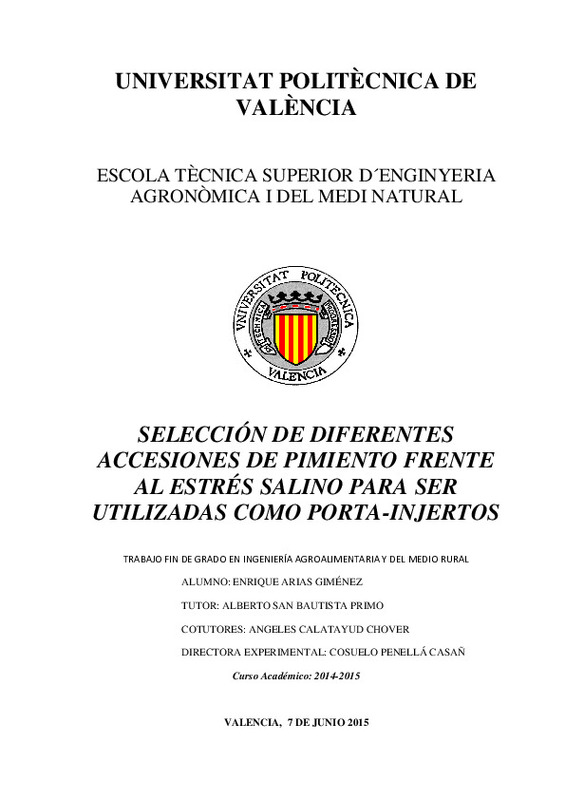|
Resumen:
|
[EN] Salinity is an environmental problem that restricts the crop production. Grafted is a
respectful and green solution for the environment. It consists of attaching a tolerant rootstock to
certain problems as diseases ...[+]
[EN] Salinity is an environmental problem that restricts the crop production. Grafted is a
respectful and green solution for the environment. It consists of attaching a tolerant rootstock to
certain problems as diseases or environmental stresses (in this case the salt stress) with a scion
susceptible to those problems, but with desired characteristics. In our study we researched 8
genotypes of the genus Capsicum annum L. to see the way they behave versus salinity with an EC of
7dS/m-1
. In order to evaluate the responses of different genotypes against salinity stress, in this work
different photosynthetic parameters were studied: net photosynthetic rate (AN, µmol CO2 m-2
s
-1
),
stomatal conductance to water vapour (gs, mol H2O m-2
s
-1
), transpiration (E, µmol H2O m-2
s
-1
) and
substomatal CO2 concentration (Ci, µmol CO2 mol-1
(air)); as well as hydric relations : water potential
(ΨW, Mpa), osmotic potential (ΨS, Mpa) and pressure potential (ΨP, Mpa). The results of this final
project prove that the genotype has higher statistic influence on all the photosynthetic parameters
than the salinity conditions per-se, indicating that genotype factor has more influence than the saline
treatment. This result indicates that the selection process is being correctly done. There weren't
significant differences in the genotypes A33, A35 y A36 between the control and saline treatments
conditions in terms of net photosynthetic parameters (AN) and stomatal conductance (gs). Our results
indicate net photosynthesis could be a useful parameter in order to select genotypes tolerant to salt
stress, and moreover these genotypes could be used as rootstocks better production, in terms of
yield and quality of the fruit under salinity conditions in grafted plants
[-]
[ES] La salinidad limita la producción mundial de numerosos cultivos incluido el pimiento. Una técnica de cultivo que puede ser utilizada para aumentar la resistencia al estrés salino es la utilización de portainjertos. ...[+]
[ES] La salinidad limita la producción mundial de numerosos cultivos incluido el pimiento. Una técnica de cultivo que puede ser utilizada para aumentar la resistencia al estrés salino es la utilización de portainjertos. Aprovechando esta tecnología, en este estudio se han utilizado diferentes accesiones de pimiento como portainjertos para analizar su comportamiento frente a la salinidad.
En este trabajo constituye una parte de las líneas de trabajo de un proyecto de investigación del Instituto Nacional de Investigaciones Agrarias (INIA), en el que colaboran la UPV y el Instituto Valenciano de Investigaciones Agrarias (IVIA). Diferentes accesiones de pimiento se sembraron y desarrollaron en los invernaderos del IVIA, y se sometieron a un estrés salino (7 dS m-1). Posteriormente, se analizaron diferentes parámetros fisiológicos como la fotosíntesis, conductancia estomática, carbono interno, transpiración y los potenciales hídrico y osmótico. La selección de las accesiones de pimiento se ha realizado en base a estos parámetros fisiológicos.
[-]
|








